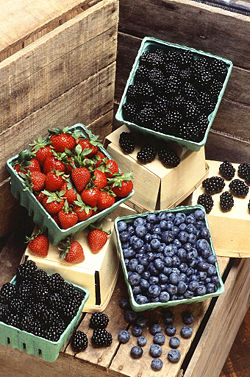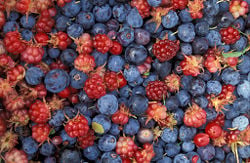Difference between revisions of "Berry" - New World Encyclopedia
Rick Swarts (talk | contribs) |
Katya Swarts (talk | contribs) |
||
| Line 1: | Line 1: | ||
{{Claimed}}{{Contracted}} | {{Claimed}}{{Contracted}} | ||
| − | |||
| − | |||
| − | + | [[Image:Berries (USDA ARS).jpg|250px|thumb|right|Several types of "berries" from the market.]] | |
| + | |||
| + | The term '''berry''', in common parlance and in [[cuisine]], refers generically to any small, edible fruit with multiple seeds. [[fruit#Aggregate fruit|Aggregate fruits]] such as the [[blackberry]], the [[raspberry]], and the [[boysenberry]] are also berries in this sense, but not the botanical. | ||
| + | |||
| + | These fruits tend to be small, sweet, juicy, and of a bright color contrasting with their background to make them more attractive to animals that eat them, thus [[biological dispersal|dispersing]] the seeds of the plant. | ||
| + | |||
| + | As berry colors derive from natural [[pigments]] synthesized by the plant, a special field of health research<ref>{{cite paper | ||
| + | | author = Gross PM | ||
| + | | title = Scientists zero in on health benefits of berry pigments | ||
| + | | date = 2007-07-09 | ||
| + | | publisher = Natural Products Information Center | ||
| + | | url = http://www.npicenter.com/anm/templates/newsATemp.aspx?articleid=18944&zoneid=201 | ||
| + | | accessdate = 2007-07-31 | ||
| + | }}</ref> has focused on the anti-disease properties of pigmented [[polyphenols]], such as [[flavonoids]], [[anthocyanins]], and [[tannins]] among other [[phytochemicals]] localized mainly in berry [[peels]] (skins) and [[seeds]]. Related to the biological properties of berry pigments is [[antioxidant]] ability for which berries are notable due to their relatively high [[oxygen radical absorbance capacity]] ("ORAC") among plant foods.<ref>{{cite paper | ||
| + | | author = Wu X, Beecher GR, Holden JM, Haytowitz DB, Gebhardt SE, Prior RL | ||
| + | | title = Lipophilic and hydrophilic antioxidant capacities of common foods in the United States | ||
| + | | publisher = J Agric Food Chem 2004 Jun 16;52(12):4026-37. | ||
| + | | date = 2004-06-16 | ||
| + | | url = http://www.ncbi.nlm.nih.gov/entrez/query.fcgi?db=pubmed&cmd=Retrieve&dopt=AbstractPlus&list_uids=15186133&query_hl=2&itool=pubmed_DocSum | ||
| + | | accessdate = 2007-07-31 | ||
| + | }}</ref> Together with good nutrient content, ORAC distinguishes several berries within a new category of [[functional foods]] called "[[superfruit]]s", a rapidly growing multi-billion dollar industry which began in 2005.<ref>{{cite paper | ||
| + | | author = Gross PM | ||
| + | | title = Superfruits take center stage: Defining an emergent categry | ||
| + | | publisher = Natural Products Information Center | ||
| + | | date = 2007-02-26 | ||
| + | | url = http://www.npicenter.com/anm/templates/newsATemp.aspx?articleid=17826&zoneid=201 | ||
| + | | accessdate = 2007-07-31 | ||
| + | }}</ref> | ||
| − | + | ==Botany== | |
| − | In | + | In [[botany]], the '''berry''' is the most common type of simple fleshy [[fruit]]; a fruit in which the entire [[ovary (plants)|ovary]] wall ripens into an edible [[pericarp]]. The flowers of these plants have a [[ovary (plants)#superior ovary|superior ovary]] and they have one or more [[carpel]]s within a thin covering and very fleshy interiors. The [[seed]]s are embedded in the common flesh of the ovary. Examples of botanical berries include the [[tomato]], [[grape]], [[litchi]], [[loquat]], [[plantain]], [[avocado]], [[persimmon]], [[eggplant]], [[guava]], [[uchuva]] (ground cherry), and [[chile pepper]]. |
| − | + | The fruit of [[citrus]], such as the [[orange (fruit)|orange]], [[kumquat]] and [[lemon]], is a modified berry called a ''[[hesperidium]]''. The fruit of [[cucumber]]s and their relatives are modified berries called "[[Pepo|pepoes]]". A plant that bears berries is referred to as ''bacciferous''. | |
{| class="wikitable" | {| class="wikitable" | ||
| Line 15: | Line 40: | ||
! colspan=4 | Botanical parlance | ! colspan=4 | Botanical parlance | ||
|- | |- | ||
| − | ! | + | ! Berry |
! Pepo | ! Pepo | ||
| − | ! | + | ! Hesperidium |
! Not a berry | ! Not a berry | ||
|- | |- | ||
! rowspan=2 | Common parlance | ! rowspan=2 | Common parlance | ||
! Berry | ! Berry | ||
| − | | [[Ribes|Currant]], [[Cranberry]], [[Blueberry]], [[Gooseberry]] | + | | [[Grape]], [[Ribes|Currant]], [[Cranberry]], [[Blueberry]], [[Banana]], [[Gooseberry]] |
| | | | ||
| | | | ||
| Line 28: | Line 53: | ||
|- | |- | ||
! Not a berry | ! Not a berry | ||
| − | | | + | | [[Tomato]], [[Persimmon]], [[Eggplant]], [[Guava]], [[Chili pepper]], [[Pomegranate]], [[Avocado]], [[Kiwifruit]], |
| − | + | | [[squash (fruit)|Squash]], [[Pumpkin]], [[Gourd]], [[Cucumber]], [[Melon]], [[Cantaloupe]], [[Watermelon]] | |
| − | | [[Orange (fruit)|Orange]], [[Lemon]], [[Grapefruit]] | + | | [[Orange (fruit)|Orange]], [[Lemon]], [[Lime (fruit)|Lime]], [[Grapefruit]] |
| − | | [[Apple]], [[Peach]], [[Green bean]], [[Sunflower seed]] | + | | [[Apple]], [[Peach]], [[Cherry]], [[Green bean]], [[Sunflower seed]] |
| + | |- | ||
|} | |} | ||
| + | |||
| + | [[Image:Alaska wild berries.jpg|250px|thumb|right|Alaska wild "berries" from the [[Innoko National Wildlife Refuge]].]] | ||
| + | |||
| + | ==Notes== | ||
| + | <references /> | ||
==See also== | ==See also== | ||
*[[List of fruits]] | *[[List of fruits]] | ||
| − | *[[ | + | *[[Epigynous berry]] |
==External links== | ==External links== | ||
| − | *[http://www.nccpg.com/Default.Aspx?Page.Aspx?Page=161 The National Council for the Conservation of Plants and Gardens] - | + | *[http://www.nccpg.com/Default.Aspx?Page.Aspx?Page=161 The National Council for the Conservation of Plants and Gardens] - Description of berries |
| − | *[http://encarta.msn.com/encyclopedia_761576964/Fruit.html] - | + | *[http://encarta.msn.com/encyclopedia_761576964/Fruit.html Encarta.msn.com] - Differentiation between true berries, pepos, and hesperidia |
| + | |||
{{fruits}} | {{fruits}} | ||
| − | + | {{credit|148982659}} | |
| − | {{credit| | ||
[[Category:Life sciences]] | [[Category:Life sciences]] | ||
Revision as of 12:58, 4 August 2007
The term berry, in common parlance and in cuisine, refers generically to any small, edible fruit with multiple seeds. Aggregate fruits such as the blackberry, the raspberry, and the boysenberry are also berries in this sense, but not the botanical.
These fruits tend to be small, sweet, juicy, and of a bright color contrasting with their background to make them more attractive to animals that eat them, thus dispersing the seeds of the plant.
As berry colors derive from natural pigments synthesized by the plant, a special field of health research[1] has focused on the anti-disease properties of pigmented polyphenols, such as flavonoids, anthocyanins, and tannins among other phytochemicals localized mainly in berry peels (skins) and seeds. Related to the biological properties of berry pigments is antioxidant ability for which berries are notable due to their relatively high oxygen radical absorbance capacity ("ORAC") among plant foods.[2] Together with good nutrient content, ORAC distinguishes several berries within a new category of functional foods called "superfruits", a rapidly growing multi-billion dollar industry which began in 2005.[3]
Botany
In botany, the berry is the most common type of simple fleshy fruit; a fruit in which the entire ovary wall ripens into an edible pericarp. The flowers of these plants have a superior ovary and they have one or more carpels within a thin covering and very fleshy interiors. The seeds are embedded in the common flesh of the ovary. Examples of botanical berries include the tomato, grape, litchi, loquat, plantain, avocado, persimmon, eggplant, guava, uchuva (ground cherry), and chile pepper.
The fruit of citrus, such as the orange, kumquat and lemon, is a modified berry called a hesperidium. The fruit of cucumbers and their relatives are modified berries called "pepoes". A plant that bears berries is referred to as bacciferous.
| Botanical parlance | |||||
|---|---|---|---|---|---|
| Berry | Pepo | Hesperidium | Not a berry | ||
| Common parlance | Berry | Grape, Currant, Cranberry, Blueberry, Banana, Gooseberry | Strawberry, Blackberry, Raspberry, Boysenberry | ||
| Not a berry | Tomato, Persimmon, Eggplant, Guava, Chili pepper, Pomegranate, Avocado, Kiwifruit, | Squash, Pumpkin, Gourd, Cucumber, Melon, Cantaloupe, Watermelon | Orange, Lemon, Lime, Grapefruit | Apple, Peach, Cherry, Green bean, Sunflower seed | |
Notes
- ↑ Gross PM (2007-07-09). "Scientists zero in on health benefits of berry pigments". Natural Products Information Center. Retrieved 2007-07-31.
- ↑ Wu X, Beecher GR, Holden JM, Haytowitz DB, Gebhardt SE, Prior RL (2004-06-16). "Lipophilic and hydrophilic antioxidant capacities of common foods in the United States". J Agric Food Chem 2004 Jun 16;52(12):4026-37.. Retrieved 2007-07-31.
- ↑ Gross PM (2007-02-26). "Superfruits take center stage: Defining an emergent categry". Natural Products Information Center. Retrieved 2007-07-31.
See also
- List of fruits
- Epigynous berry
External links
- The National Council for the Conservation of Plants and Gardens - Description of berries
- Encarta.msn.com - Differentiation between true berries, pepos, and hesperidia
Credits
New World Encyclopedia writers and editors rewrote and completed the Wikipedia article in accordance with New World Encyclopedia standards. This article abides by terms of the Creative Commons CC-by-sa 3.0 License (CC-by-sa), which may be used and disseminated with proper attribution. Credit is due under the terms of this license that can reference both the New World Encyclopedia contributors and the selfless volunteer contributors of the Wikimedia Foundation. To cite this article click here for a list of acceptable citing formats.The history of earlier contributions by wikipedians is accessible to researchers here:
The history of this article since it was imported to New World Encyclopedia:
Note: Some restrictions may apply to use of individual images which are separately licensed.
| Types of fruits | |
|---|---|
| Berries | Drupes | Pomes | Aggregate fruits | False berries |

